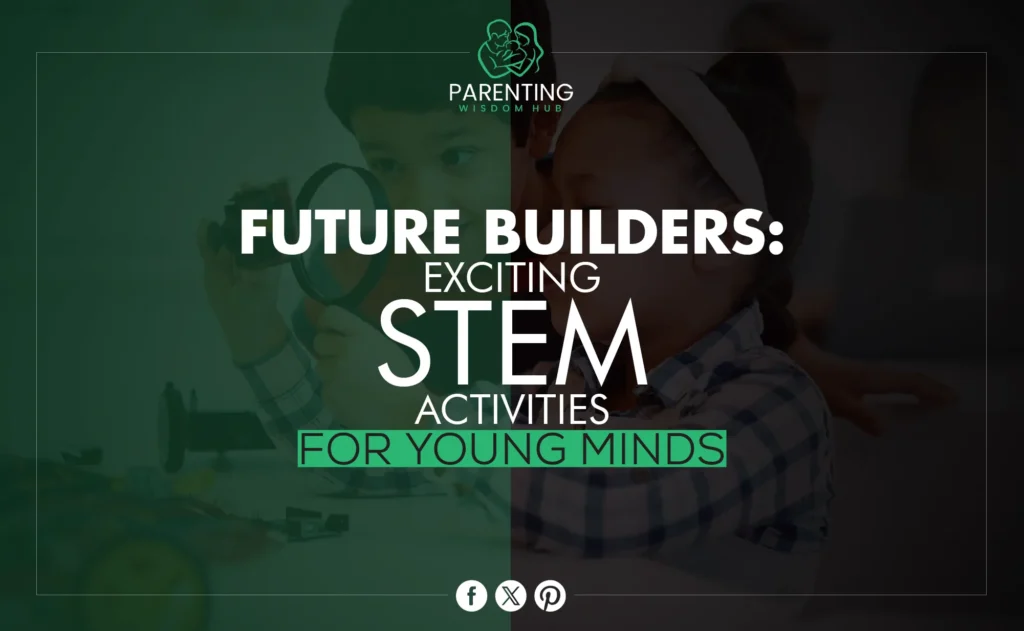Introduction
“Scientists discover the world that exists; engineers create the world that never was.” – Theodore von Kármán.
STEM subjects, such as science, technology, engineering, and math, help shape our future by creating new ideas, intelligent people, and problem-solving people.
STEM activities are essential for kids’ development and jobs. Early STEM education develops critical thinking, creativity, and problem-solving. It gives young people the skills to succeed in a tech-driven environment. STEM activities foster curiosity and investigation, preparing kids for academic and professional success.
This blog will cover fun STEM activities for kids. From hands-on science experiments to technology-based projects, engineering challenges, and mathematical tasks, each part includes clear instructions and emphasizes their educational worth. As a parent, teacher, or caregiver, these activities will inspire and motivate kids to become builders and inventors.
Stay tuned as we dive into the world of STEM and give you and the kids in your helpful life tips and fun, creative ideas for learning that will stick with them.
If you want different ideas about indoor activities, kindly visit the blog.
Section 1: The Benefits of STEM Education
Critical Thinking and Problem Solving
STEM activities challenge kids to think critically and solve challenges. Building a stable bridge from popsicle sticks or programming a robot requires youngsters to assess circumstances, discover patterns, and find solutions. This procedure improves their logic and problem-solving skills, which are helpful in school and life.
Creativity and Innovation
STEM education emphasizes creativity and innovation, which is exciting. Children are encouraged to experiment, take risks, and think creatively through hands-on projects. The possibilities are unlimited when designing a new robot or research experiment. This freedom to explore and invent fosters an innovative mindset that views failure as a learning experience.
Career Readiness
STEM exposure early on can boost a child’s professional prospects. Strong STEM backgrounds prepare students for employment in highly demanded fields such as science, technology, engineering, and mathematics. STEM activities increase skills and enthusiasm in STEM occupations, encouraging children to study and work.
Fun and Engagement
STEM activities are enriching and entertaining. They make learning fun by letting kids create, explore, and discover. STEM activities engage kids, whether they’re programming a robot or seeing a volcano erupt. Enjoying studying makes it seem like a fun challenge, creating a lifelong passion for discovery and learning.
Section 2: Hands-On Science Experiments
Volcano Eruption Experiment:
Materials Needed:
- Baking soda
- Vinegar
- Dish soap
- Red food coloring
- A small plastic bottle
- A tray or large dish
- Modeling clay or play dough (optional for creating the volcano shape)
Step-by-Step Instructions:
- The bottle should be put in the middle of the tray or dish.
- You can use play dough or modeling clay to make the bottle look like a volcano but leave the top open.
- Put two tablespoons of baking soda into the bottle.
- Put a few drops of dish soap in the bottle.
- Add a few drops of red food coloring to make it look like lava.
- Watch as the bottle erupts after adding 1/2 cup of vinegar.
Educational Value:
Baking soda and vinegar react in the volcanic eruption experiment. Carbon dioxide gas from their combination causes the bubbling and foaming eruption. This experiment teaches kids about chemical reactions, acids and bases, and scientific observation and documentation.
Growing Crystals:
Materials Needed:
- Epsom salt or table salt
- Water
- A clear glass or jar
- A spoon
- Food coloring (optional)
- A piece of string or a pipe cleaner
- A pencil or popsicle stick
Step-by-Step Instructions:
- It’s time to boil that cup of water, but first, make it very warm.
- Add Epsom salt or table salt to the warm water to make a complete solution and stir it constantly until no more salt dissolves.
- You can make colorful crystals by adding a few drops of food coloring to the solution.
- The answer should be put into a clear glass or jar.
- Attach a pipe cleaner or piece of string to the heart of a pencil or popsicle stick.
- Place the pencil or popsicle stick on top of the jar. Ensure the string or pipe cleaner hangs into the solution without hitting the sides or bottom.
- Don’t touch the jar for a few hours or overnight. Please leave it in a cool place. The string or pipe cleaner will start to get crystals on it.
- Remove the string or pipe cleaner from the solution once crystals have formed, and let it dry.
Educational Value:
Growing crystals educates kids about crystallization and solids and liquids. Children can see that the dissolved salt creates crystalline crystals by cooling a saturated solution. This experiment teaches crystal formation, solubility, and saturation.
Section 3: Technology-Based Activities
Coding for Kids:
Programming involves instructing computers to accomplish tasks. In today’s tech-driven environment, it helps kids learn reasoning, problem-solving, and creativity. Learning to code early prepares kids for computer careers and helps them grasp the digital world.
Resources and Platforms:
Kids can learn to code in a fun and easy way on several sites that are great for beginners:
- Scratch: Scratch is an MIT program that lets kids create stories, games, and videos using a simple drag-and-drop interface.
- Org: It has many coding lessons and games for kids and adults of all ages, such as the well-known Hour of Code.
- Tynker: Offers engaging coding classes and projects for kids of all ages, focusing on making games and telling stories.
Sample Project:
Making an easy animation in Scratch is a fun way for kids to learn how to code. To begin, follow these steps:
- Create a new project: Startup Scratch and do a new project.
- Choose a sprite: Pick out a figure (sprite) from the library in Scratch.
- Add a background: Pick a background for your movie from the library.
- Create a script: Use the blocks in the code area to create a script for your sprite. For example, if the green flag is clicked, you can make the sprite move forward 10 steps.
- Add more actions: Try giving the sprite different things to do, like making it talk, change color, or play a sound.
- Run the project: Click the green flag to see your animated work.
Building Simple Robots:
Robotics uses engineering, coding, and electronics to build autonomous or guided devices. Robotics teaches kids about machines and problem-solving, critical thinking, and collaboration.
DIY Robotics Kits:
A lot of do-it-yourself robot kits are made for people who are just starting:
- Lego Mindstorms: A well-known set that lets kids use Lego bricks to build and control robots.
- VEX Robotics: There are different kits for people with different skill levels, focusing on STEM education.
- Ozobot: Tiny robots that are simple to control and can be written with color codes or a block-based programming language.
Step-by-Step Guide:
To put together a simple robot using an easy-to-follow kit, here are the steps:
- Unbox the kit: Open the robotics kit you picked and arrange all the parts on the table.
- Read the instructions: Follow the directions that came with the kit.
- Assemble the body: Follow the step-by-step instructions in the guidebook to start building the robot’s body.
- Add the electronics: Follow the directions to connect the motors, sensors, and other electrical parts.
- Connect to a computer: You can connect the robot to a computer using the USB cord or Bluetooth.
- Program the robot: Use the software in the kit to create a simple program. You can tell the robot to move forward, turn, or avoid obstacles.
- Test and refine: After running the program, watch how the robot works and make any necessary changes to improve its performance.
Section 4: Engineering Challenges
Bridge Building Challenge:
Materials Needed:
- Popsicle sticks
- Glue (wood glue or hot glue)
- Ruler
- Pencil
- Paper for sketching the design
Step-by-Step Instructions:
- Sketch the Design: Make a rough model of your bridge on paper. Think about what kind of bridge it is (beam, truss, arch, etc.) and how to spread the weight out properly.
- Measure and Cut: Mark the popsicle sticks with a ruler to fit your pattern. If necessary, cut them.
- Construct the Base: Start by assembling the bridge’s base. Place two popsicle sticks next to each other and glue them together. Add more sticks to the base to make it stronger.
- Build the Supports: Glue popsicle sticks vertically to the base to make the bridge’s supports. Make sure that the supports are lined up and spaced out properly.
- Add the Deck: To create the bridge’s deck, glue popsicle sticks horizontally across the supports.
- Reinforce the Structure: Adding more popsicle sticks diagonally or in a truss design can strengthen the bridge and evenly distribute the weight.
- Test the Bridge: To determine the strength of your bridge, add weight slowly until it breaks. Then, check how much weight it can support and find ways to strengthen it.
Educational Value:
Bridge-building challenges teach kids engineering concepts, including load distribution, structural stability, and tension and compression forces. Building and testing their bridges teaches kids about design and material choices for stable, efficient structures. This interactive activity promotes creativity, problem-solving, and critical thinking.
Egg Drop Challenge:
Materials Needed:
- Raw eggs
- Various materials for cushioning (e.g., straws, cotton balls, bubble wrap, newspaper)
- Tape
- Scissors
- Plastic bags or containers
Step-by-Step Instructions:
- Gather Materials: Gather a range of things that can shield the egg before it falls.
- Design the Protector: Draw a plan for your egg guardian to protect the egg from breaking when it hits something.
- Construct the Protector: With the collected resources, build an egg protector. The egg can be wrapped in bubble wrap, placed in a padded container, or suspended with straws and tape.
- Test the Protector: The egg should be placed in the protector and dropped from a certain height (1 meter). Check if the egg breaks after falling.
- Refine the Design: Identify the problem and improve the design if the egg cracks. Then, test the revised design again.
Educational Value:
The egg drop challenge teaches kids gravity, force, and material strength. Designing and testing protectors helps kids absorb and distribute impact forces to avoid harm. Children improve their guardians according to test findings, encouraging creativity, exploration, and iterative design.
Section 5: Mathematics Activities
Math Puzzles and Games:
Arithmetic puzzles and games entertain kids. These activities make abstract subjects fun and engaging, promoting a positive attitude toward arithmetic and a more excellent knowledge of its fundamentals.
Examples:
- Sudoku: The classic logic-based number puzzle helps kids learn critical thinking and pattern recognition. Players complete a 9×9 grid with 1–9 digits in each column, row, and 3×3 subgrid.
- Math Bingo: In this exciting version, every bingo tile has a math challenge. Players solve tasks to mark squares and complete rows, columns, and diagonals.
- Math Tic-Tac-Toe: Players don’t put Xs and Os where they belong; instead, they answer math problems to earn marks. They can put their mark on the grid if they get it right.
Educational Value:
Math games and puzzles practice addition, subtraction, multiplication, division, reasoning, and problem-solving. These activities help kids learn math in a fun, stress-free way.
DIY Math Board Games:
Materials Needed:
- Cardboard or a large piece of paper (for the game board)
- Markers or colored pencils
- Dice
- Game pieces (could be small toys, coins, etc.)
- Index cards or small pieces of paper (for question cards)
- Ruler
Step-by-Step Instructions:
- Design the Game Board: Choose a theme for your math board game (space travel, treasure hunt). Draw a path for players on cardboard or paper.
- Create Question Cards: Write math questions on index cards. Depending on participants ‘ skill levels, these can be simple or more sophisticated arithmetic.
- Decorate the Board: Decorate the game board using markers or colored pencils to match the theme. Add “Move Forward 2 Spaces” or “Go Back 1 Space” to spice up the game.
- Set the Rules: Choose your game rules. For instance, players roll the dice to move their pieces along the path and must solve a math problem from the question cards when they fall on a place.
- Play the Game: After explaining the rules, play with the players. Encourage children to solve problems alone or with minimal help to learn.
Educational Value:
Kids learn arithmetic and problem-solving by making and playing DIY math board games. Game design requires preparation and imagination, while play reinforces math principles through repetition. Board games promote strategic thinking and teamwork, making arithmetic fun and collaborative.
Conclusion
Parents and educators should actively involve kids in STEM activities. Hands-on learning and exploration can inspire young people to enjoy science, technology, engineering, and math. These exercises develop critical abilities and inspire curiosity and creativity, laying the groundwork for academic and career success. Help your kids learn STEM by encouraging experimenting, asking questions, and praising their successes.
Please share your STEM activities and others you’ve tried with your kids. Your tales and ideas can inspire others and develop a community of learners who will grow and innovate. Leave a comment or follow us on social media to help us promote STEM education for kids.


